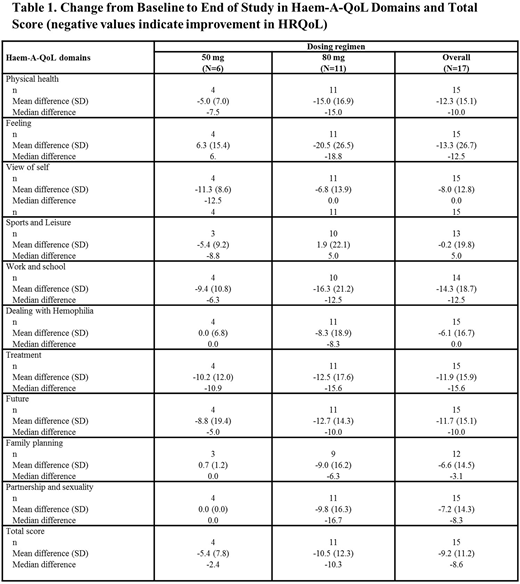Background:
Fitusiran, an investigational RNA interference treatment for people with hemophilia A or B (PwH), with or without inhibitors, has shown dose-dependent lowering of antithrombin, increase in thrombin generation, and decrease in bleeding frequency in clinical trials. The novel mechanism of action and long pharmacodynamic effect enables once-monthly subcutaneous administration. This sustained hemostatic protection and less burdensome administration may improve patient-reported outcomes (PRO).
Objective:
To evaluate changes in PRO in terms of patient-relevant improvements in health-related quality of life (HRQoL) in PwH with inhibitors (PwHI) on prophylactic fitusiran treatment.
Methods:
Fitusiran was evaluated in a phase 1 dose-escalation study (NCT02035605) followed by a phase 2 open-label extension (OLE) study (NCT02554773) with monthly subcutaneous fixed doses of 50 mg or 80 mg. HRQoL was assessed using the Haem-A-QoL and the EuroQol 5 Dimensions (EQ-5D) questionnaires at baseline and at end of study in a cohort of 17 PwHI (Hemophilia A, n=15; Hemophilia B, n=2) from the phase 1 study.
Results:
Subjects previously treated on-demand or prophylactically had a mean (standard deviation [SD]) age of 34.6 (10.3) years and a mean (SD) number of bleeding episodes in the 6 months before baseline of 16.6 (10.7). Mean (SD) changes from baseline to end of study (day 84 or later) in Haem-A-QoL total (-9.2 [11.2]) and physical health (−12.3 [15.1]) domain scores suggest clinically meaningful improvement (lower scores indicate better HRQoL). Numeric reduction (i.e., improvement) in all other domains appeared to be dose-dependent (greater improvement in the 80 mg group) (Table 1). Changes in EQ-5D utility and EQ-VAS scores were not clinically meaningful. Further analyses in PwH with and without inhibitors from the phase 2 OLE will be presented.
Conclusions:
Fitusiran prophylaxis may improve HRQoL - particularly the Haem-A-QoL 'Physical health' domain (painful swelling, joint pain, pain with movement, difficulty walking, and time to get ready) as shown in a cohort of 17 PwHI . Additional analyses from ongoing OLE and phase 3 studies are planned to quantify the patient-relevant changes with fitusiran treatment in all hemophilia patients over time.
Von Mackensen:Sanofi, Bayer, Sobi, Chugai, Kedrion, Spark: Consultancy; Biotest, Sobi, CSL Behring: Honoraria; Novo Nordisk, Sobi: Research Funding. Chowdary:BioMarin: Honoraria; Bayer, CSL Behring, Freeline, Novo Nordisk, Pfizer and Sobi: Research Funding; Chugai, CSL Behring, Novo Nordisk, Pfizer, Roche, Sobi: Speakers Bureau; Bayer, Chugai, CSL Behring, Freeline, Novo Nordisk, Pfizer, Roche, Sanofi, Shire (Baxalta), Sobi, Spark: Membership on an entity's Board of Directors or advisory committees. Mangles:Roche, Takeda, Novo Nordisk: Consultancy, Membership on an entity's Board of Directors or advisory committees; Sobi, Octapharma, Novo Nordisk, Shire and Roche/Chugai: Other: travel funding. Yu:Sanofi: Other: was an employee and stockholder of Sanofi, at the time of study; Albireo Pharmaceuticals, Inc: Current Employment. Mei:Sanofi: Current Employment, Current equity holder in publicly-traded company. Andersson:Sanofi: Current Employment, Current equity holder in publicly-traded company. Dasmahapatra:Sanofi: Current Employment, Current equity holder in publicly-traded company.
Author notes
Asterisk with author names denotes non-ASH members.


This feature is available to Subscribers Only
Sign In or Create an Account Close Modal